“I’d have been drystock farming and [with that alone] it’s not possible to make a living,” says Bill Buckley.
“If I wanted to continue farming, I knew I would have to find something else.”
I’m in Bill’s home near Banteer, Co Cork. Thanks to his background in carpentry, his house is beautifully crafted.
It is surrounded by forestry and, at 950 feet above sea level, offers breathtaking views of the surrounding north Cork region. He is telling me why he decided to start growing hemp.
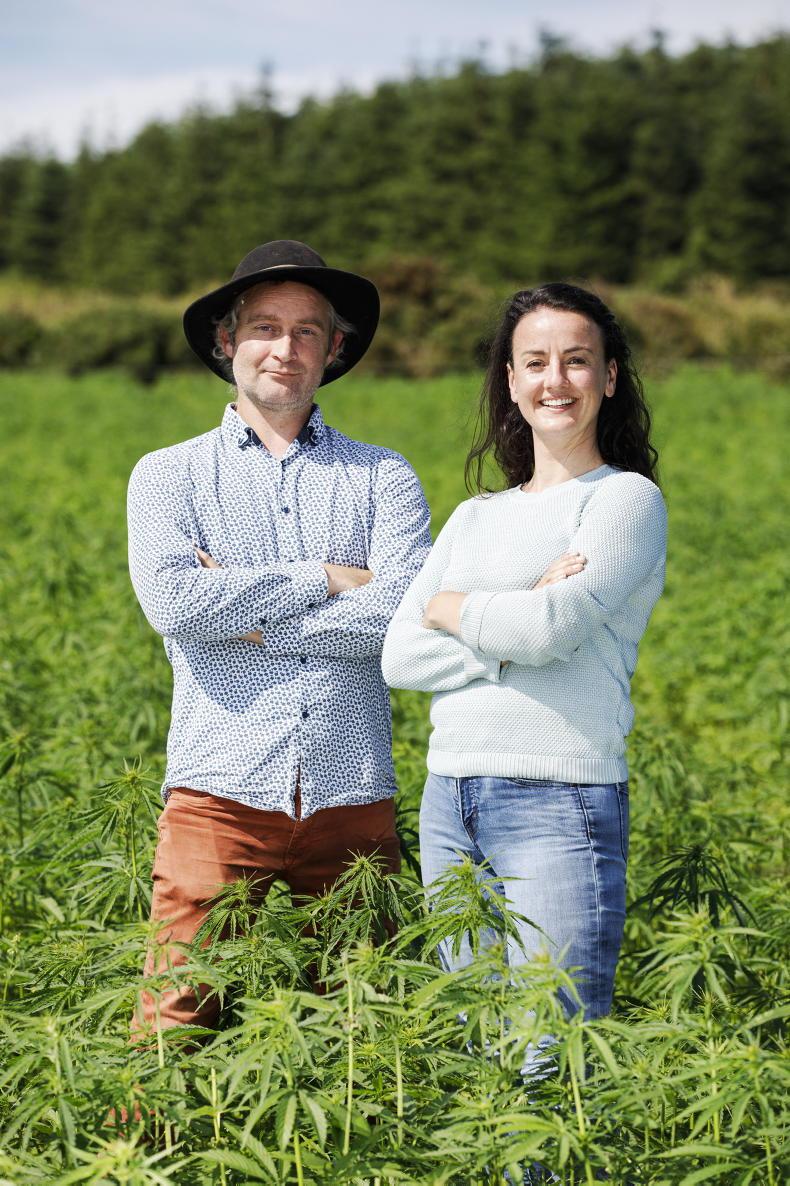
Daniel Lyons and Laura Jayne Foley own and operate Wild Atlantic Hemp in Loop Head, Co Clare. \ Donal O'Leary
Bill’s land, while beautiful, is also considered marginal. For him, growing hemp was an opportunity to add to his farming income. He continues to raise cattle – most notably a herd of 18 Kerry cattle (a native breed). He is currently licensed to grow hemp for cannabidiol (CBD) oil production.
With his business, MountainGrown.ie, he is making higher-altitude CBD oil. A scholarly article published on Swiss-based platform MDPI (Multidisciplinary Digital Publishing Institute) indicates hemp grown at higher altitudes is often of a superior quality.
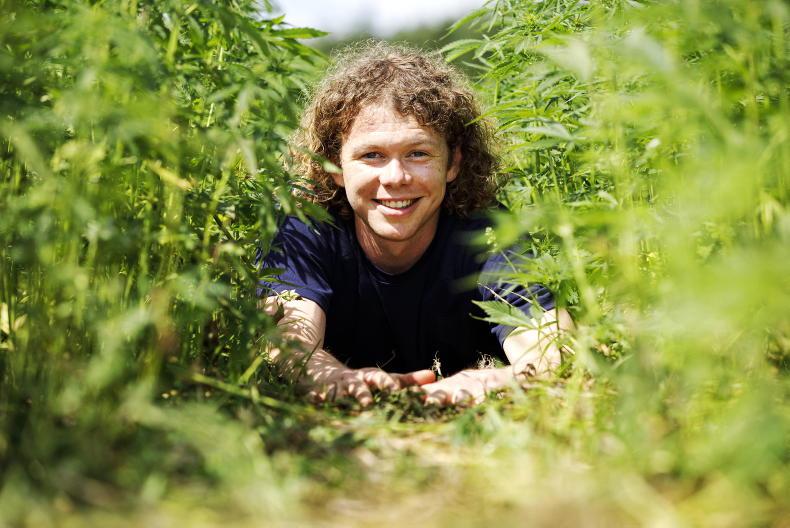
Darragh Hayes grows hemp on his grandparents' farm in Ballydesmond. \ Donal O'Leary
“This is my second year growing hemp,” he explains. “In the beginning, I really didn’t know what I was doing. I rang Kate Carmody (chair of Hemp Cooperative Ireland) about it and asked if it could grow on marginal land and she said it would. She said it would ‘beat the rushes’ and it’s true. The rushes come back but the hemp will beat them – they’ll outgrow them.”
Hemp-growing community
I’m not alone on my visit to Bill – there are other people here too. They are all involved in the growing, processing and selling of hemp in Ireland. Darragh Hayes, who is in his 20s, is currently growing hemp on his grandparents’ 57ac farm on the Cork/Kerry border.
“I moved back to Ireland in March,” he says.
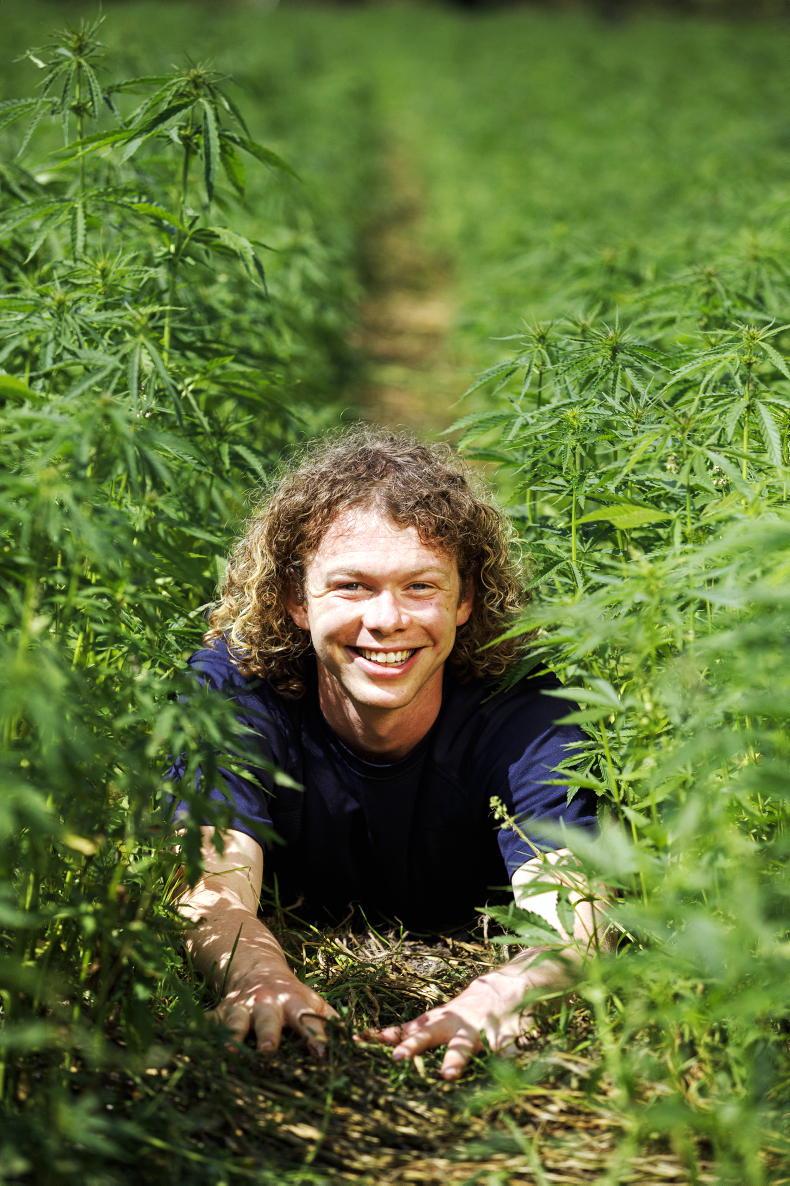
Darragh learned about hemp while he was on a working holiday visa in Vancouver, Canada. \ Donal O'Leary
“I was in Berlin and Vancouver and Vancouver was my first introduction to hemp, I suppose. I moved home and was caring for my grandfather with Alzheimer’s, and I needed a project to keep myself going.
“My grandfather had a cattle farm in Ballydesmond,” he continues. “I thought it would be nice to see if we could make farming in that area lucrative. I got into hemp through Teagasc. I was filling in the forms for grants for my grandad and I was asking if anyone in north Cork was growing hemp. They said: ‘There’s only one person and that’s Bill Buckley.’”
Laura Foley and Daniel Lyons are also present. They own and operate Wild Atlantic Hemp on the Loop Head peninsula in Co Clare. They grow in small amounts – mainly for research and development purposes – and have an on-site processing unit where they make their full-spectrum CBD oil. They also process for other members of the co-operative (like Bill), so the option is there for farmers’ to develop their own brands of CBD oil.

Bill Buckley farms drystock and hemp in Banteer, Co Cork. \ Donal O'Leary
As graduates of the NUIG Innovation in Agriculture programme, they have developed a system for hemp processing which is fully compliant with all state agencies, including the Food Safety Authority of Ireland (FSAI).
Hemp Cooperative Ireland
Hemp Cooperative Ireland, of which Laura, Daniel, Darragh and Bill are all members, was established in 2018. The cooperative mainly exists for support and knowledge-sharing purposes. This is necessary because growing hemp in Ireland is no simple thing. Paperwork, harvesting and processing require serious effort. Laura is a board member on the co-operative. She says they started with seven members at their first meeting, but now have over 200.
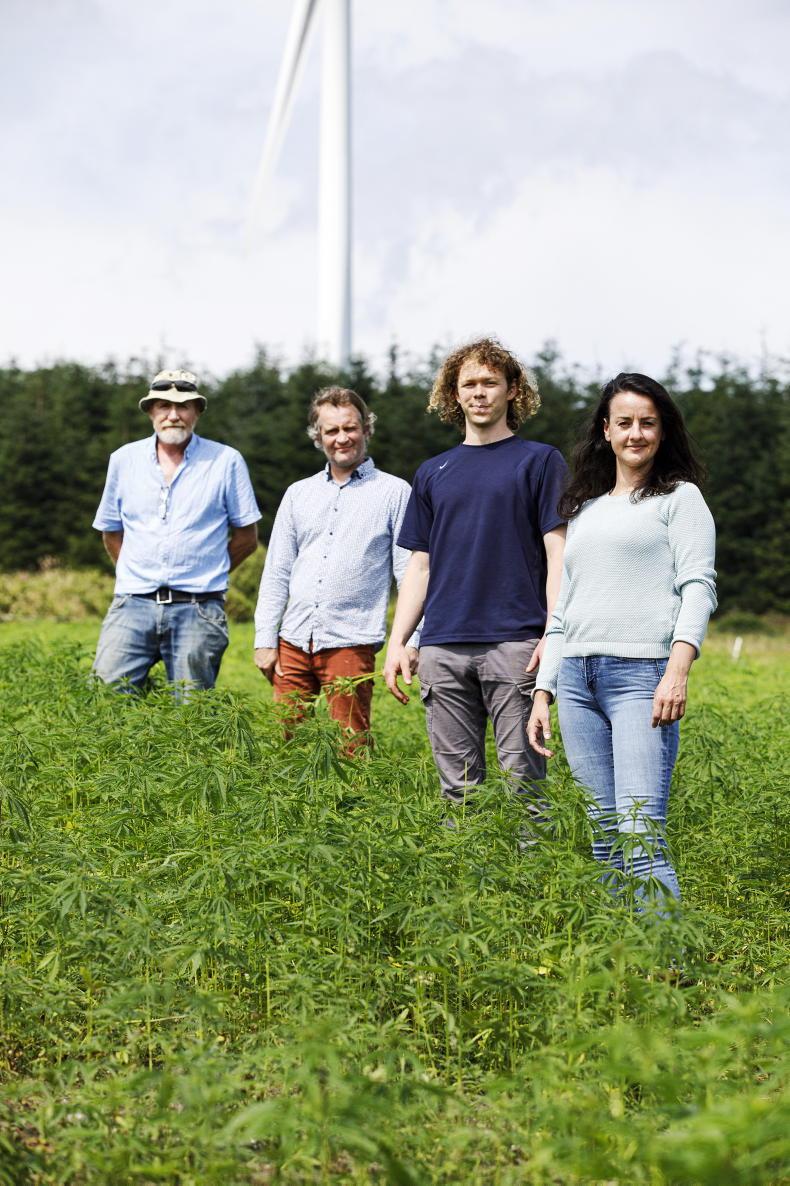
Bill, Daniel, Darragh and Laura are all members of Hemp Cooperative Ireland. \ Donal O'Leary
“There are people in the co-op who are ecologists, farmers, producers and researchers,” she explains. “There’s a good mix, and we’re looking at growing hemp from all the different facets: fibre production investigation, the agronomy side of things – how best to plant it. Then, as well, we act as kind of a connection between the different Government bodies [involved in regulation].”
Why bother?
“If it’s so difficult, why would anyone attempt to grow hemp?” you might ask. The answer comes down to these elements: farm diversification, positive environmental impact and – cha ching! – potential to earn decent money for your crop. Hemp grows well in most environments, and quickly: from seed to harvest within 90 days. Currently, Daniel and Laura pay farmers €5 to €15 per kg of CBD-grade hemp. For a one-acre crop, you can make up to €3,000.
Hemp is farmed for three different things: fibre, seed and flowers. From these things, a plethora of products can be made – from hempseed oil to face creams to building materials. However, the most lucrative product at the moment is CBD oil. Part of what the Hemp Cooperative wants to show is that it doesn’t take much space or time to grow hemp for CBD production, but it can be of great benefit to Irish farmers.
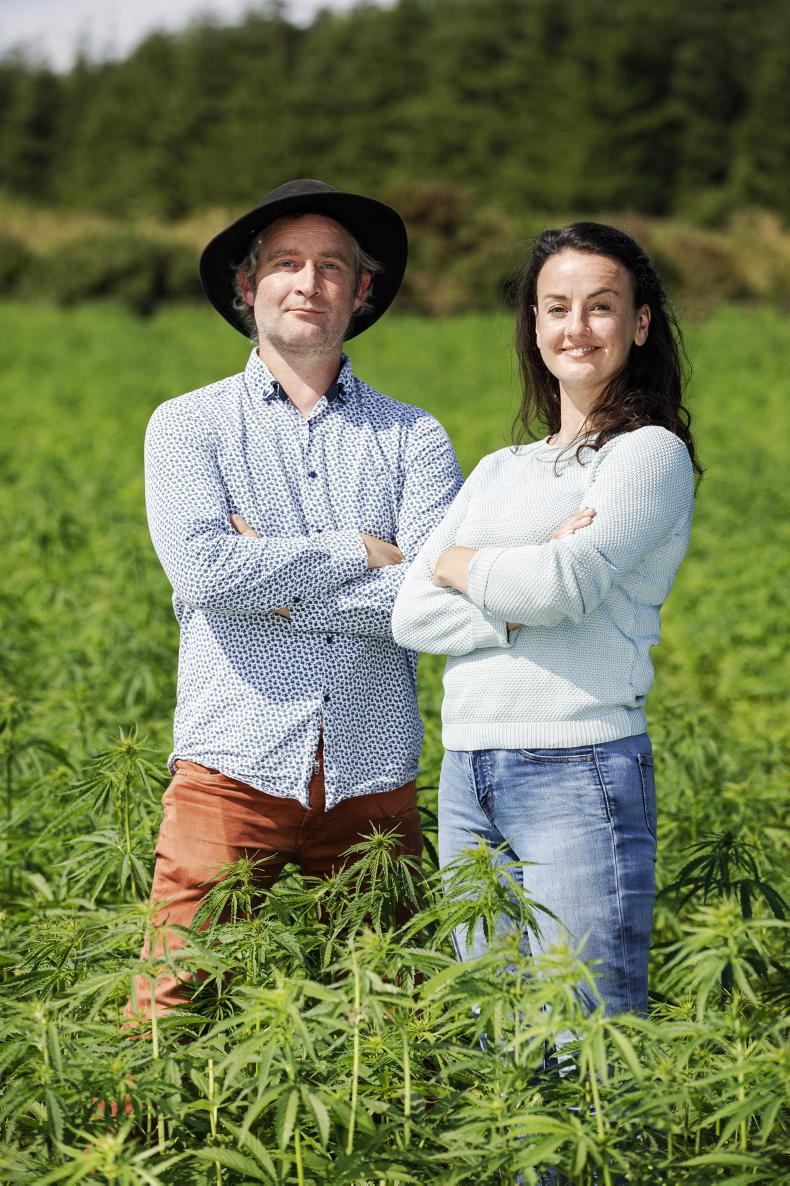
Daniel Lyons and Laura Jayne Foley grow small amounts of hemp for research purposes and process other farmers' hemp into CBD oil . \ Donal O'Leary
“The CBD side of hemp is worth more money,” Daniel explains. “If you’re growing for seed or fibre, you need to grow up to 30ac, but for CBD you could go from one to 5ac and make just as much money as if you were growing 30ac.”
Popularity of CBD
While refraining from making specific health claims around CBD intake, in recent years it has surged in popularity for a variety of health and wellness reasons. Some claim it helps stress and anxiety while others use it to help with seizures. Those suffering from arthritis and chronic pain are also among regular CBD users. It can be taken orally or used topically.
A 2020 article (Cannabidiol (CBD)-what we know and what we don’t) published on Harvard University’s health website states: “CBD has been touted for a wide variety of health issues, but the strongest scientific evidence is for its effectiveness in treating some of the cruellest childhood epilepsy syndromes, such as Dravet syndrome and Lennox-Gastaut syndrome (LGS), which typically don’t respond to antiseizure medications. In numerous studies, CBD was able to reduce the number of seizures and, in some cases, it was able to stop them altogether.”
“It can work for epilepsy,” Daniel says. “Once we’re established I would like to set up a charity for people needing CBD for those purposes. The amount they have to pay for their medicine every month is astronomical. You want to try and give something back.”
Regulations
Because hemp is considered a food, but contains minimal amounts of tetrahydrocannabinol (THC) – which is prohibited in Ireland as the main psychoactive ingredient in cannabis – its growth is monitored by the Department of Health under the Health Products Regulatory Authority (HPRA) as opposed to being monitored by the Department of Agriculture (DAFM).
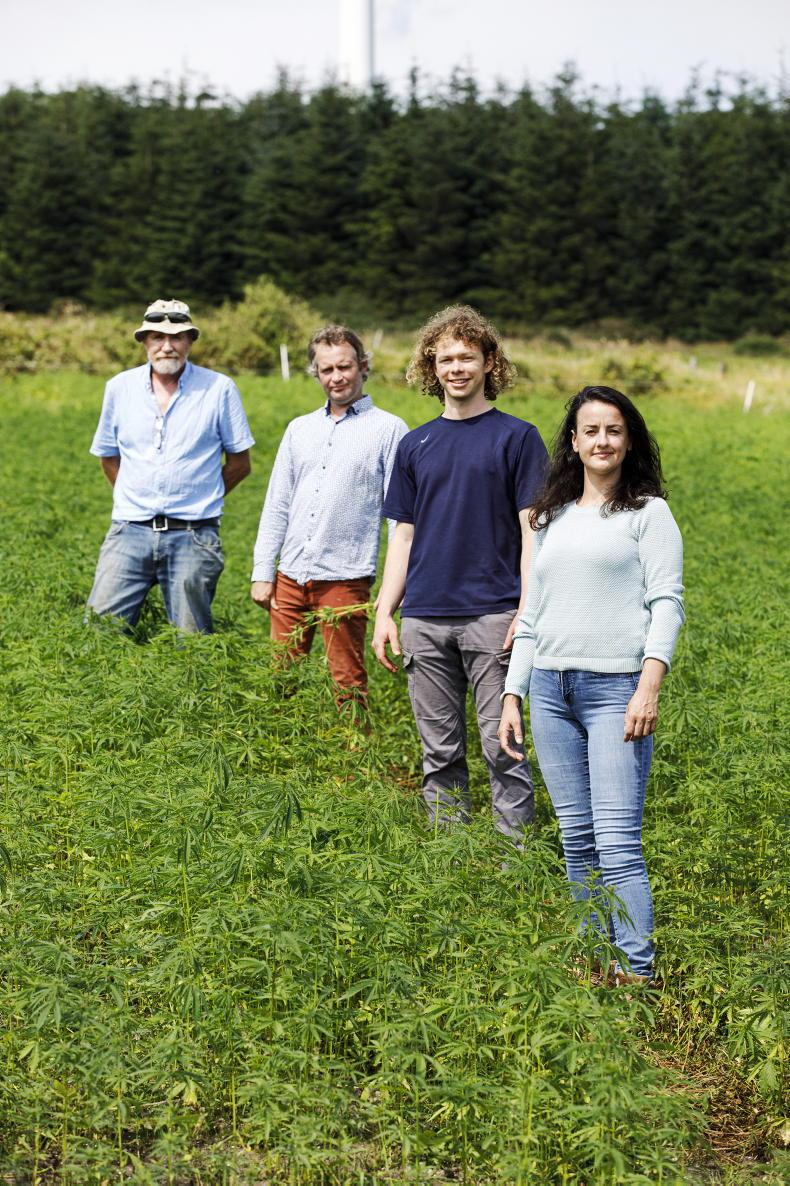
Bill, Daniel, Darragh and Laura are all members of Hemp Cooperative Ireland. \ Donal O'Leary
This, many feel, is the wrong approach. Because it is agricultural, THC levels are barely admissible and the benefits of hemp as a crop are positive, most believe the DAFM is better suited to monitoring hemp production.
“It should really be the DAFM dealing with hemp,” Daniel says. “There is still a massive taboo around hemp in relation to cannabis – and it is related but you’re not going to get high off it. There is a minimal amount of THC in CBD; it’s like 0.2%. Buying cannabis off the street, the THC would be around 20% – so 100 times stronger.”
Licensing
To legally grow hemp in Ireland, you need to apply for a license from the HPRA each year. It’s been noted by co-operative members that the HPRA can often leave farmers waiting for approval; largely due to the increase in applications over the past three years. As a result, the cooperative now helps members with the necessary paperwork. Irish Country Living has been told that, this year, applications for licensing were up 120%, but with only one person dedicated to processing applications, turnover has been slow.
Hemp sowing generally happens in and around May and is then harvested in August, so the delay in processing license applications can be crippling if delayed too long. Some are only just hearing they have been approved to grow hemp this year.
“People applying for a license and only getting approved in August is absolutely ridiculous,” Daniel says. “The season is over by that time.”
They say turnaround for license renewals are quicker, but that having to apply for a new license each year is a turn-off for many farmers. Daniel and Laura believe a five-year license would work well and better suit Ireland’s hemp farmers.
More red tape
There are other issues with growing hemp in Ireland. You cannot legally remove hemp flower heads (for CBD production) from your property because they contain small amounts of THC. If you don’t have a processing unit on-site, how can you get your CBD made? Laura and Daniel have developed a process to remove CBD from flower heads directly on the farmers’ land before taking it back to their facility (which is how Bill is able to have his CBD processed), but this service is not available to everyone.
Hemp farmers must, under current legislation, destroy the hemp flower and, as cannabinoids are produced in the flower head
This is a major roadblock for many would-be hemp growers in Ireland.
The Teagasc website (under Industrial Hemp Production) also highlights this legislation:
“Hemp farmers must, under current legislation, destroy the hemp flower and, as cannabinoids are produced in the flower head, this is yet another regulatory barrier to the development of an Irish hemp-derived food and cannabinoid market.”
Variety matters
Because farmers plant a certain variety of hemp depending on the end product (there are varieties better suited to fibre, for example, which grow up to 3m high), certain seeds are preferred when growing hemp for CBD.
Current regulations mean Irish hemp growers can only bring in seed from the European Seed Database. Most of the hemp seed in this database is better suited for fibre or seed production.
We’re not sure if that’s because of restrictions or just lack of demand
CBD is only made from female – or feminised – plants. If farmers could purchase entirely feminised hemp seed (mainly sold in North America), their earnings per crop would increase dramatically (from €3,000/ac to €20,000/ac, according to Daniel).
“There is one type of seed [in the European Seed Database], called Finola, which could be made feminised,” Laura says, “but the person who owns the copyright hasn’t feminised it. We’re not sure if that’s because of restrictions or just lack of demand.”
Harvesting and processing
The Irish hemp industry is still in its infancy and major developments need to be made. Since farmers first started growing hemp (in the early 2010s), the largest problem has been the lack of processing and harvesting infrastructure.
“If we wanted to have a huge [hemp] fibre market in Ireland, we would need a decorticator (hemp processing machine) – and there isn’t a decorticator in the country, yet, that can do industrial amounts,” Laura says. “We’re still in that period where everybody’s trying to figure out how well it grows in their specific area. It’s a bit of a learning curve.”
If you’re coming in with a combine, you need to retrofit it a little bit
If a farmer only grows one to three acres of hemp per year, much of the maintenance and harvesting can be done with hand tools and smaller machines. This also helps maintain the quality of the hemp flower, if growing for CBD. For fibre or seed over larger areas, a combine is most commonly used and there are other potential problems of which to be aware. Hemp fibres are extremely strong – they can and will wrap themselves around any bit of machinery sticking out.
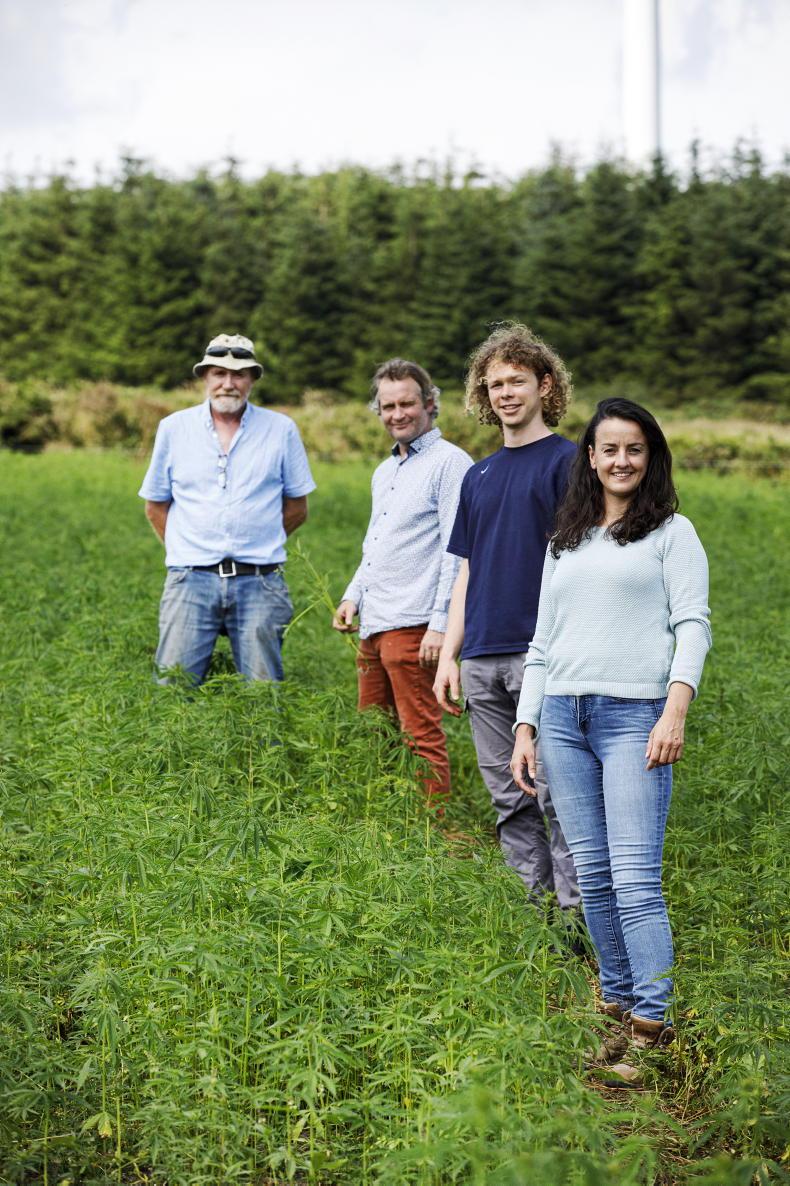
Bill, Daniel, Darragh and Laura are all members of Hemp Cooperative Ireland. \ Donal O'Leary
“If you’re coming in with a combine, you need to retrofit it a little bit,” Daniel says. “If there’s a nut or bolt or anything sticking out of it, you have to put down masking tape – tape down any nooks and crannies. But it can be done with a combine.
“If you’re up to three acres, you can just handball it in,” he continues. “Up from five acres, you want a stripper header, which leaves the stalks but pulls the flower heads off. You can preserve your flower that way for CBD production.”
Visit wildatlantichemp.com and hempcooperativeireland.com
Read more
Why is Ireland’s organic farming rate so low?
A new route to market for Irish wool?
“I’d have been drystock farming and [with that alone] it’s not possible to make a living,” says Bill Buckley.
“If I wanted to continue farming, I knew I would have to find something else.”
I’m in Bill’s home near Banteer, Co Cork. Thanks to his background in carpentry, his house is beautifully crafted.
It is surrounded by forestry and, at 950 feet above sea level, offers breathtaking views of the surrounding north Cork region. He is telling me why he decided to start growing hemp.

Daniel Lyons and Laura Jayne Foley own and operate Wild Atlantic Hemp in Loop Head, Co Clare. \ Donal O'Leary
Bill’s land, while beautiful, is also considered marginal. For him, growing hemp was an opportunity to add to his farming income. He continues to raise cattle – most notably a herd of 18 Kerry cattle (a native breed). He is currently licensed to grow hemp for cannabidiol (CBD) oil production.
With his business, MountainGrown.ie, he is making higher-altitude CBD oil. A scholarly article published on Swiss-based platform MDPI (Multidisciplinary Digital Publishing Institute) indicates hemp grown at higher altitudes is often of a superior quality.

Darragh Hayes grows hemp on his grandparents' farm in Ballydesmond. \ Donal O'Leary
“This is my second year growing hemp,” he explains. “In the beginning, I really didn’t know what I was doing. I rang Kate Carmody (chair of Hemp Cooperative Ireland) about it and asked if it could grow on marginal land and she said it would. She said it would ‘beat the rushes’ and it’s true. The rushes come back but the hemp will beat them – they’ll outgrow them.”
Hemp-growing community
I’m not alone on my visit to Bill – there are other people here too. They are all involved in the growing, processing and selling of hemp in Ireland. Darragh Hayes, who is in his 20s, is currently growing hemp on his grandparents’ 57ac farm on the Cork/Kerry border.
“I moved back to Ireland in March,” he says.

Darragh learned about hemp while he was on a working holiday visa in Vancouver, Canada. \ Donal O'Leary
“I was in Berlin and Vancouver and Vancouver was my first introduction to hemp, I suppose. I moved home and was caring for my grandfather with Alzheimer’s, and I needed a project to keep myself going.
“My grandfather had a cattle farm in Ballydesmond,” he continues. “I thought it would be nice to see if we could make farming in that area lucrative. I got into hemp through Teagasc. I was filling in the forms for grants for my grandad and I was asking if anyone in north Cork was growing hemp. They said: ‘There’s only one person and that’s Bill Buckley.’”
Laura Foley and Daniel Lyons are also present. They own and operate Wild Atlantic Hemp on the Loop Head peninsula in Co Clare. They grow in small amounts – mainly for research and development purposes – and have an on-site processing unit where they make their full-spectrum CBD oil. They also process for other members of the co-operative (like Bill), so the option is there for farmers’ to develop their own brands of CBD oil.

Bill Buckley farms drystock and hemp in Banteer, Co Cork. \ Donal O'Leary
As graduates of the NUIG Innovation in Agriculture programme, they have developed a system for hemp processing which is fully compliant with all state agencies, including the Food Safety Authority of Ireland (FSAI).
Hemp Cooperative Ireland
Hemp Cooperative Ireland, of which Laura, Daniel, Darragh and Bill are all members, was established in 2018. The cooperative mainly exists for support and knowledge-sharing purposes. This is necessary because growing hemp in Ireland is no simple thing. Paperwork, harvesting and processing require serious effort. Laura is a board member on the co-operative. She says they started with seven members at their first meeting, but now have over 200.

Bill, Daniel, Darragh and Laura are all members of Hemp Cooperative Ireland. \ Donal O'Leary
“There are people in the co-op who are ecologists, farmers, producers and researchers,” she explains. “There’s a good mix, and we’re looking at growing hemp from all the different facets: fibre production investigation, the agronomy side of things – how best to plant it. Then, as well, we act as kind of a connection between the different Government bodies [involved in regulation].”
Why bother?
“If it’s so difficult, why would anyone attempt to grow hemp?” you might ask. The answer comes down to these elements: farm diversification, positive environmental impact and – cha ching! – potential to earn decent money for your crop. Hemp grows well in most environments, and quickly: from seed to harvest within 90 days. Currently, Daniel and Laura pay farmers €5 to €15 per kg of CBD-grade hemp. For a one-acre crop, you can make up to €3,000.
Hemp is farmed for three different things: fibre, seed and flowers. From these things, a plethora of products can be made – from hempseed oil to face creams to building materials. However, the most lucrative product at the moment is CBD oil. Part of what the Hemp Cooperative wants to show is that it doesn’t take much space or time to grow hemp for CBD production, but it can be of great benefit to Irish farmers.

Daniel Lyons and Laura Jayne Foley grow small amounts of hemp for research purposes and process other farmers' hemp into CBD oil . \ Donal O'Leary
“The CBD side of hemp is worth more money,” Daniel explains. “If you’re growing for seed or fibre, you need to grow up to 30ac, but for CBD you could go from one to 5ac and make just as much money as if you were growing 30ac.”
Popularity of CBD
While refraining from making specific health claims around CBD intake, in recent years it has surged in popularity for a variety of health and wellness reasons. Some claim it helps stress and anxiety while others use it to help with seizures. Those suffering from arthritis and chronic pain are also among regular CBD users. It can be taken orally or used topically.
A 2020 article (Cannabidiol (CBD)-what we know and what we don’t) published on Harvard University’s health website states: “CBD has been touted for a wide variety of health issues, but the strongest scientific evidence is for its effectiveness in treating some of the cruellest childhood epilepsy syndromes, such as Dravet syndrome and Lennox-Gastaut syndrome (LGS), which typically don’t respond to antiseizure medications. In numerous studies, CBD was able to reduce the number of seizures and, in some cases, it was able to stop them altogether.”
“It can work for epilepsy,” Daniel says. “Once we’re established I would like to set up a charity for people needing CBD for those purposes. The amount they have to pay for their medicine every month is astronomical. You want to try and give something back.”
Regulations
Because hemp is considered a food, but contains minimal amounts of tetrahydrocannabinol (THC) – which is prohibited in Ireland as the main psychoactive ingredient in cannabis – its growth is monitored by the Department of Health under the Health Products Regulatory Authority (HPRA) as opposed to being monitored by the Department of Agriculture (DAFM).

Bill, Daniel, Darragh and Laura are all members of Hemp Cooperative Ireland. \ Donal O'Leary
This, many feel, is the wrong approach. Because it is agricultural, THC levels are barely admissible and the benefits of hemp as a crop are positive, most believe the DAFM is better suited to monitoring hemp production.
“It should really be the DAFM dealing with hemp,” Daniel says. “There is still a massive taboo around hemp in relation to cannabis – and it is related but you’re not going to get high off it. There is a minimal amount of THC in CBD; it’s like 0.2%. Buying cannabis off the street, the THC would be around 20% – so 100 times stronger.”
Licensing
To legally grow hemp in Ireland, you need to apply for a license from the HPRA each year. It’s been noted by co-operative members that the HPRA can often leave farmers waiting for approval; largely due to the increase in applications over the past three years. As a result, the cooperative now helps members with the necessary paperwork. Irish Country Living has been told that, this year, applications for licensing were up 120%, but with only one person dedicated to processing applications, turnover has been slow.
Hemp sowing generally happens in and around May and is then harvested in August, so the delay in processing license applications can be crippling if delayed too long. Some are only just hearing they have been approved to grow hemp this year.
“People applying for a license and only getting approved in August is absolutely ridiculous,” Daniel says. “The season is over by that time.”
They say turnaround for license renewals are quicker, but that having to apply for a new license each year is a turn-off for many farmers. Daniel and Laura believe a five-year license would work well and better suit Ireland’s hemp farmers.
More red tape
There are other issues with growing hemp in Ireland. You cannot legally remove hemp flower heads (for CBD production) from your property because they contain small amounts of THC. If you don’t have a processing unit on-site, how can you get your CBD made? Laura and Daniel have developed a process to remove CBD from flower heads directly on the farmers’ land before taking it back to their facility (which is how Bill is able to have his CBD processed), but this service is not available to everyone.
Hemp farmers must, under current legislation, destroy the hemp flower and, as cannabinoids are produced in the flower head
This is a major roadblock for many would-be hemp growers in Ireland.
The Teagasc website (under Industrial Hemp Production) also highlights this legislation:
“Hemp farmers must, under current legislation, destroy the hemp flower and, as cannabinoids are produced in the flower head, this is yet another regulatory barrier to the development of an Irish hemp-derived food and cannabinoid market.”
Variety matters
Because farmers plant a certain variety of hemp depending on the end product (there are varieties better suited to fibre, for example, which grow up to 3m high), certain seeds are preferred when growing hemp for CBD.
Current regulations mean Irish hemp growers can only bring in seed from the European Seed Database. Most of the hemp seed in this database is better suited for fibre or seed production.
We’re not sure if that’s because of restrictions or just lack of demand
CBD is only made from female – or feminised – plants. If farmers could purchase entirely feminised hemp seed (mainly sold in North America), their earnings per crop would increase dramatically (from €3,000/ac to €20,000/ac, according to Daniel).
“There is one type of seed [in the European Seed Database], called Finola, which could be made feminised,” Laura says, “but the person who owns the copyright hasn’t feminised it. We’re not sure if that’s because of restrictions or just lack of demand.”
Harvesting and processing
The Irish hemp industry is still in its infancy and major developments need to be made. Since farmers first started growing hemp (in the early 2010s), the largest problem has been the lack of processing and harvesting infrastructure.
“If we wanted to have a huge [hemp] fibre market in Ireland, we would need a decorticator (hemp processing machine) – and there isn’t a decorticator in the country, yet, that can do industrial amounts,” Laura says. “We’re still in that period where everybody’s trying to figure out how well it grows in their specific area. It’s a bit of a learning curve.”
If you’re coming in with a combine, you need to retrofit it a little bit
If a farmer only grows one to three acres of hemp per year, much of the maintenance and harvesting can be done with hand tools and smaller machines. This also helps maintain the quality of the hemp flower, if growing for CBD. For fibre or seed over larger areas, a combine is most commonly used and there are other potential problems of which to be aware. Hemp fibres are extremely strong – they can and will wrap themselves around any bit of machinery sticking out.

Bill, Daniel, Darragh and Laura are all members of Hemp Cooperative Ireland. \ Donal O'Leary
“If you’re coming in with a combine, you need to retrofit it a little bit,” Daniel says. “If there’s a nut or bolt or anything sticking out of it, you have to put down masking tape – tape down any nooks and crannies. But it can be done with a combine.
“If you’re up to three acres, you can just handball it in,” he continues. “Up from five acres, you want a stripper header, which leaves the stalks but pulls the flower heads off. You can preserve your flower that way for CBD production.”
Visit wildatlantichemp.com and hempcooperativeireland.com
Read more
Why is Ireland’s organic farming rate so low?
A new route to market for Irish wool?












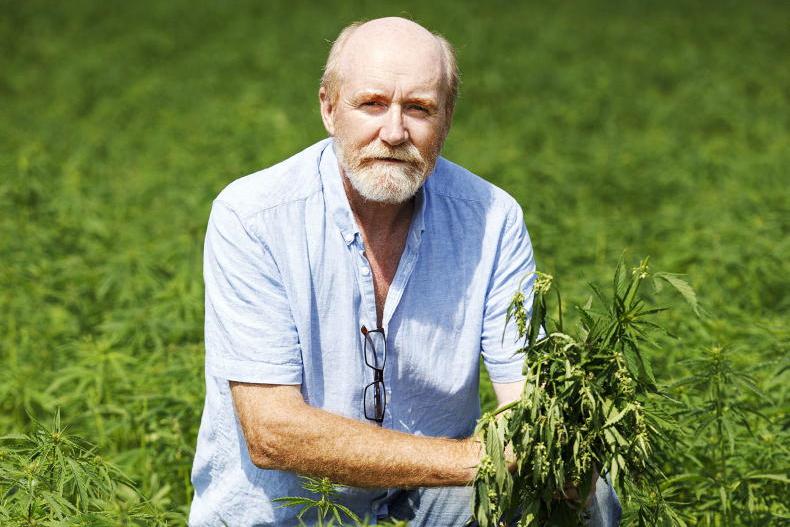
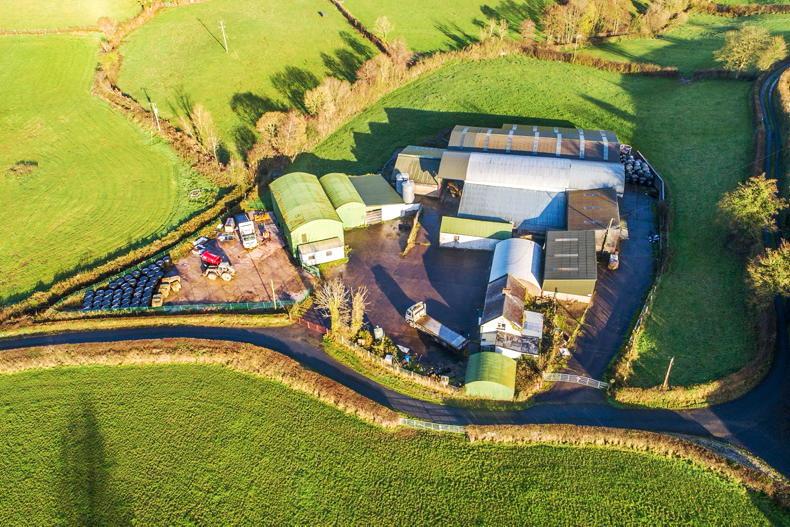
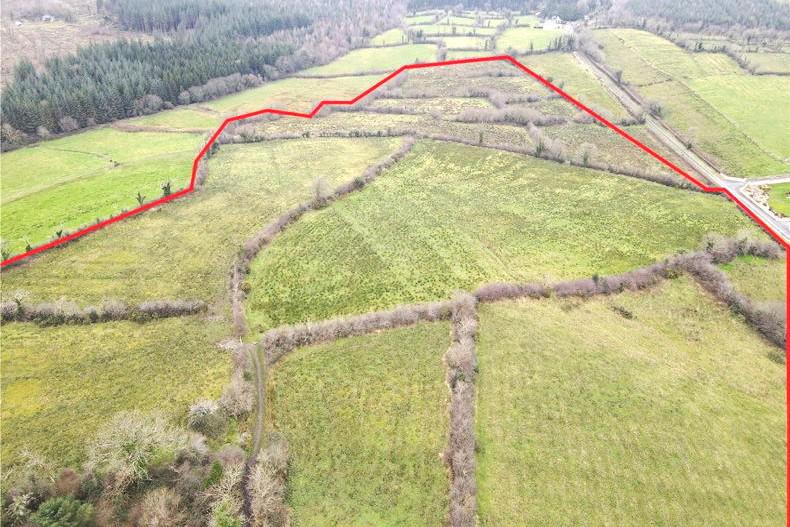
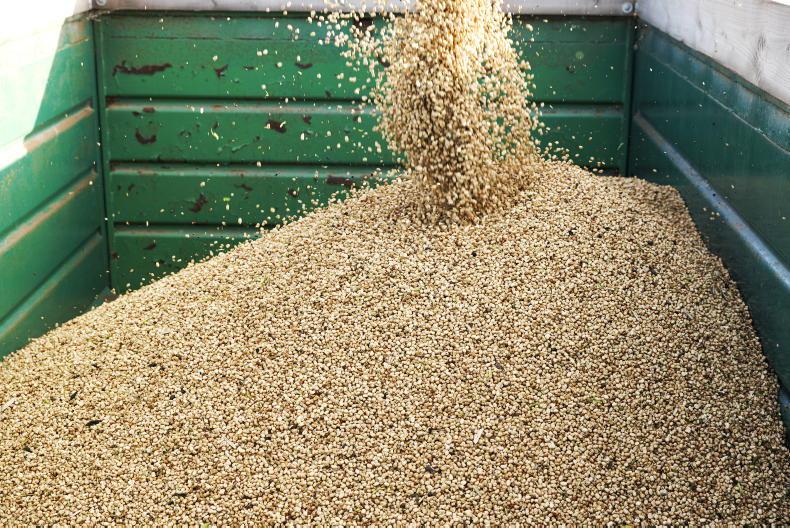
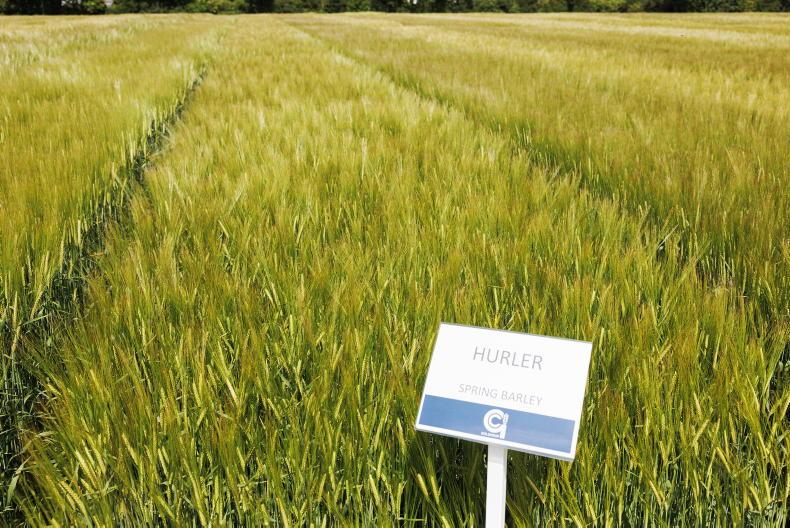
SHARING OPTIONS